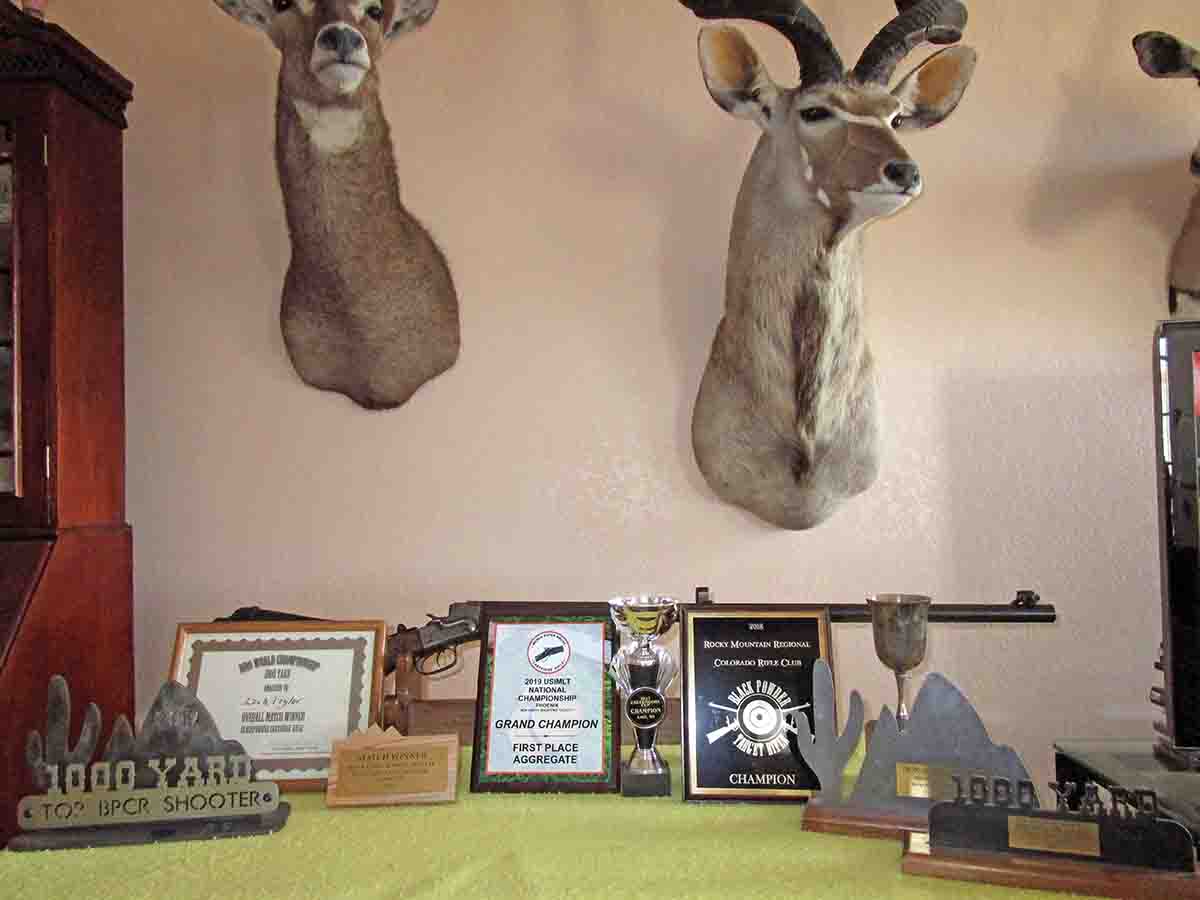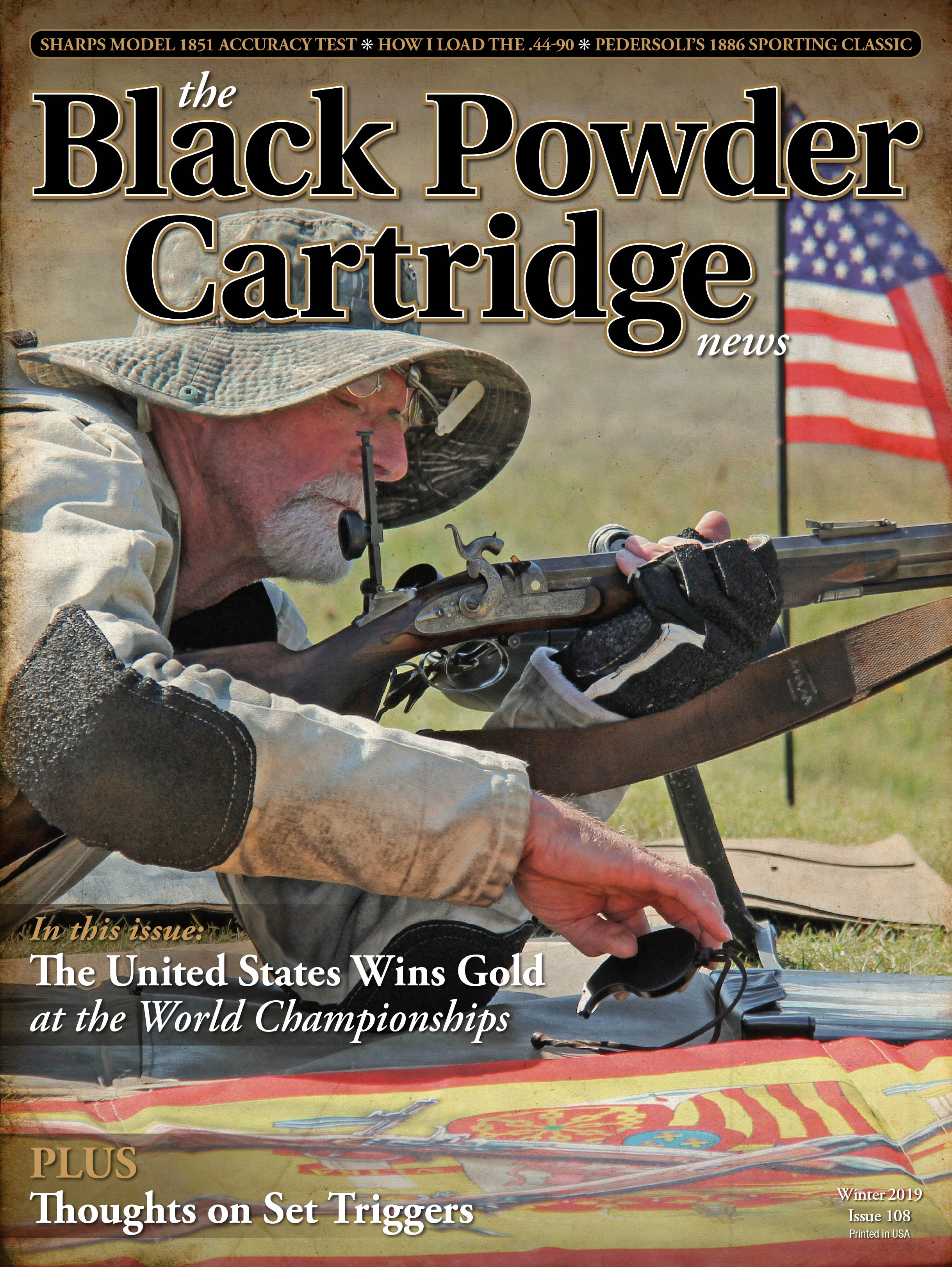How I Load the .45-90
for Long-Range Target Competitions
feature By: Zack Taylor | November, 19
This will be short and to the point. Loading the .45-90 and similar capacity black-powder cartridge rifle calibers has, for me, evolved into a process that is repeated each time I crack a new case of black powder or begin a relationship with a new rifle. This is about how I load the .45-90 for long-range target competition, exclusively. It is not how I load other BPCR rifles for other types of competition.

I begin by accepting the fact that each rifle is a law unto itself and the goal is to provide that rifle with the ability to minimize vertical dispersion on the target at 800, 900 and 1,000 yards by delivering a stabilized bullet at those distances. I accept the fact that consistency in loading match ammunition is paramount.
Bullets are cast from the same lot of 1-16 alloy between 780 to 820 degrees (depending on ambient temperature) as measured by a thermometer in the mix. The last 10 bullets cast from a pot are weighed, those weights are added and total weight is divided by 10 for an average weight. Bullets that are 0.6 grains over and under average are match bullets. Bullets up to 2 grains under average are used for sighters and practice. Others, if any, go back to into the pot. I use homemade lube with weather conditions determining which one gets used. I use a SAECO Lubri-Sizer with a slightly oversized sizing-die and a modified top punch to apply the lube to the bullets.
I start with a cartridge case fireformed in the subject rifle. Any quality cast .45-caliber grease-groove bullet I choose to shoot will do. (In a standard .45-90 chamber, I use BACO 459542M3, Swiss 11⁄2 Fg, Federal 150M primers, 1-16 alloy and Starline Brass.) Deburr the inside mouth of the fireformed and annealed case and ever so slightly bell the mouth of the case. Slide the base of the unlubricated bullet into the mouth of the case. The unsized bullet should slide in and out freely. Full-length size that case and bell the mouth of the case. Seat the bullet in a short distance and close the belled mouth of the case onto the body of the bullet with a taper crimper just enough to slide the dummy round easily into the chamber of the rifle. Incrementally seat the bullet deeper into the dummy case until all but half of the rim on the case goes into the chamber rim-seat with moderate to light finger pressure. Measure and record that cartridge overall length. When fully chambered, the barrel grooves should engrave the front driving band on the bullet or up to one half-inch on some tapered Money bullets. Seat the bullet into the leade until it stops in the rifling. Observe the rifling marks around the circumference of the bullet on the front contact driving band of a fully chambered round. The correct cartridge overall length is very important.
Take a second fireformed and annealed case and seat a spent primer in the primer pocket of the case. Place a .009-inch thick tag paper wad inside case over flash hole. (A .40- caliber wad punch makes the wads.) Using black powder, fill that dummy case through the drop tube until it reaches the height in the case that would bring the column in contact with the base of the seated bullet. Place a second unsized, unlubricated bullet in the case atop the powder column, spin it on top of the powder a couple of turns and add or subtract powder until the bullet is placed atop the powder column that the cartridge overall length matches the earlier measurement. Empty that powder charge into a scale pan, weigh the charge and record the weight. I use a 120-grain black-powder volumetric tube measure to determine the volume of powder it takes to establish that column height by weight when thrown from the powder measure. The volume will remain constant, lot to lot, as well as the granulation of powder but the weight may not. I use a Belding and Mull Visible powder measure for this and a 14-inch drop tube during load development by dumping the charge in at the top to go into the case. Determine the volume by measuring the depth in the tube to yield that weight of that lot of powder by measuring with the tail end of the dial caliper. Write that measurement down. Weigh thrown charges and adjust (dip-out or trickle-in) to actual grain weight. Consistency is the key.
Load four rounds using that powder charge with about a .035 thousandths wad for compression and set the compression die to obtain the cartridge overall length. Chronograph those four rounds and record the extreme spread and average velocity. Adjust the powder charge up or down to find 1,300 feet per second (fps) in that rifle, estimating 6 fps for each grain of powder. From approximately a 1,300 fps baseline load, load additional rounds in lots of four, adding 1.5 grains of powder each time for each lot of four cartridges. I adjust the compression die down each time I add powder or wads to maintain the correct cartridge overall length.
Shoot the groups of four cartridges individually through the chronograph and record the extreme spread and average velocity for each four-shot lot with an eye for an extreme spread in the single digits, with an average velocity about 1,300 fps more or less. I usually find a sweet spot between 1,300-1,360 fps with the noted components. Next, I load 10 rounds of this best combination with the smallest extreme spread and shoot them over the chronograph. If the extreme spread holds in single digits, I load 20 rounds (with an electronic trickler) and head for the range to shoot the load on paper or steel at 1,000 yards. If the accuracy is satisfactory, further testing at 800, 900 and 1,000 yards on paper targets is done before taking the load to a match. The chronograph testing works best if the rifle and ammunition is in the shade and a constant aiming point is used. I use an Oehler 35P chronograph with the first sky screen set 15 feet from the muzzle. With this bullet in an 1:18 twist barrel, about 1,330 fps works for me in my current long-range rifle.
Once I am in the “ball park” for velocity and extreme spread, I switch to an electronic powder trickler that feeds the powder charge in 40 seconds through a 36-inch drop tube directly into the cartridge case. This gives a different powder column height for the same volume and weight of powder so wad stack adjustment begins anew, but changes velocity very little. This trickling usually produces a further lowering of extreme spread.
I adjust velocity slightly by adding or subtracting the wad stack and use combinations of card, veg fiber, lDPE and HDPE wads in varying thicknesses, as needed to obtain the lowest extreme spread. Beginning at zero compression, adding compression usually lowers extreme spread. How much compression it takes for single-digit extreme spread can vary widely.
I use a Lyman .45-caliber taper crimper just enough to hold the bullets in the case when picked up nose down and chamber smoothly in all test and target cartridges. Always think uniformity.
When ready to load ammunition for a match, I calculate how much powder I will need plus one pound. I dump that quantity of powder of the same granulation, make and lot into a large glass mixing bowl and mix well with a wooden salad spoon. Then I replace the powder from the glass mixing bowl back into the original containers using the wooden spoon and wide mouth aluminum funnel.
I use all one brick of the same make and lot number of primers. I seat primers by feel using a Forester/Bonanza Primer Seater into previously annealed cases. I don’t lube bullets until I am ready to seat them in the charged case. In hot weather, I put the lubricated bullets in the refrigerator for a few minutes before loading to prevent lube transfer while loading the bullets into cases. Consistency.
If, by the time I reach 1,360 fps, the extreme spread is consistently erratic or exceeds 25 fps, I assume I have a mechanical ignition problem with the rifle rather than a load problem. Diagnosing a mechanical ignition problem with the rifle is beyond the scope of this article but it does happen.
Using this loading method, I am satisfied with the result if I can fire four consecutive rounds in stable conditions at a match and strike the five-inch diameter shot spotter disk three times in a row at 1,000 yards. Yeah, I know, I’ve heard it a thousand times; seeing it is sometimes not believing it.


